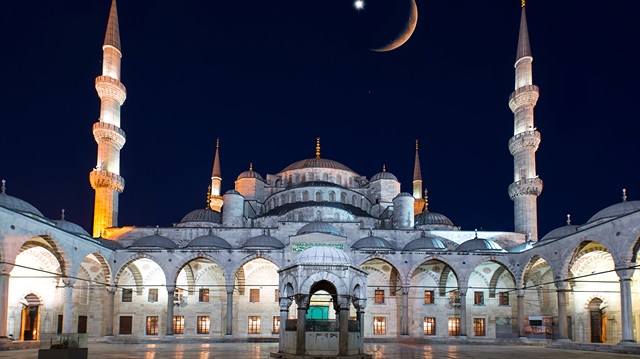The cascading domes and six slender minarets of the Sultanahmet Mosque(better known as the “Blue Mosque“) dominate the skyline of Istanbul. In the 17th century, Sultan Ahmet I wished to build an Islamic place of worship that would be even better than the Hagia Sophia, and the mosque named for him is the result. The two great architectural achievements now stand next to each other in Istanbul’s main square, and it is up to visitors to decide which is more impressive.
History
The Blue Mosque was commissioned by Sultan Ahmet I when he was only 19 years old. It was built near the Hagia Sophia, over the site of the ancient hippodrome and Byzantine imperial palace (whose mosaics can be seen in the nearby Mosaic Museum). Construction work began in 1609 and took seven years.
The mosque was designed by architect Mehmet Aga, whose unfortunate predecessor was found wanting and executed. Sultan Ahmet was so anxious for his magnificent creation to be completed that he often assisted in the work. Sadly, he died just a year after the completion of his masterpiece, at the age of 27. He is buried outside the mosque with his wife and three sons.
The original mosque complex included a madrasa, a hospital, a han, a primary school, a market, an imaret and the tomb of the founder. Most of these buildings were torn down in the 19th century.

What to See
One of the most notable features of the Blue Mosque is visible from far away: its six minarets. This is very unique, as most mosques have four, two, or just one minaret. According to one account, the Sultan directed his architect to make gold (altin) minarets, which was misunderstood as six (alti) minarets.
Whatever the origins of the unique feature, the six minarets caused quite a scandal, as the Haram Mosque in Mecca (the holiest in the world) also had six minarets. In the end, the sultan solved the problem by sending his architect to Mecca to add a seventh minaret.
The other striking feature of the exterior is the beautifully-arranged cascade of domes that seem to spill down from the great central dome. The arcades running beneath each dome add further visual rhythm. None of the exterior is blue – the name “Blue Mosque” comes from the blue tiles inside.
The main west entrance is beautifully decorated and very much worth a look. However, to preserve the mosque’s sanctity, non-worshippers are required to use the north entrance, off the Hippodrome. Hanging from this gate are symbolic chains that encourage everyone, even the sultan who entered on horseback, to bow his or her head upon entering.
Inside, the high ceiling is lined with the 20,000 blue tiles that give the mosque its popular name. Fine examples of 16th-century Iznik design, the oldest tiles feature flowers, trees and abstract patterns. The overall effect is one of the most beautiful sights in Istanbul. The Iznik tiles can be seen in the galleries and and on the north wall above the main entrance. The remaining tiles, which have a less delicate design, were made in Kütahya.
The interior is lit with 260 windows, which were once filled with 17th-century stained glass. Sadly, this has been lost and replaced with inferior replicas.
Festivals and Events
On summer evenings at 9pm, there is a historical narrative and a light show at the Blue Mosque. The commentaries are given in Turkish, English, French and German on various evenings.
Quick Facts
| Site Information | |
| Names: | Blue Mosque; Sultanahmet Camii; Sultanahmet Mosque |
| Location: | Istanbul, Turkey |
| Faith: | Islam |
| Category: | Mosques |
| Architecture: | Ottoman |
| Date: | 1609-16 |
| Patron(s): | Sultan Ahmet I |
| Architect: | Mehmet Aga |
| Size: | Interior: 53m x 51m Dome diameter: 23.5m Dome height: 43m |
| Features: | Medieval Tiles |
| Status: | active |
| Photo gallery: | Blue Mosque Photo Gallery |
| Visitor Information | |
| Address: | Sultanahmet, Istanbul, Turkey |
| Coordinates: | 41.005277° N, 28.976827° E (view on Google Maps) |
| Lodging: | View hotels near this location |
| Phone: | |
| Public transport: | Tram: Sultanahmet |
| Opening hours: | Daily 9am-6pm except during prayer times (about 30 min. five times a day) and midday on Fridays |
| Cost: | Free |
| Rules: | Tourists must enter through the north gate and remove their shoes at the entrance (plastic bags for shoes are provided). Modest dress is required for both men and women; women must cover their heads. Wraps are provided when deemed necessary by mosque officials. |
Note: This information was accurate when published and we do our best to keep it updated, but details such as opening hours can change without notice. To avoid disappointment, please check with the site directly before making a special trip.
Hiç yorum yok:
Yorum Gönder